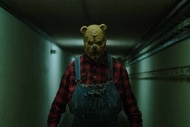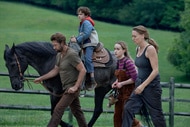Create a free profile to get unlimited access to exclusive videos, sweepstakes, and more!
Binge mode or weekly release? How Netflix and Disney+ release shows is a big, big deal

For Disney, 2019 ended on a mostly very high note. While the company has had to weather the mixed reaction related to Star Wars: The Rise of Skywalker, the movie has made nearly a billion dollars and counting, and Disney also had massive success with its new streaming service, Disney+, and its own Star Wars story, the eight-episode first season of The Mandalorian.
When it opened for digital business on November 12, Disney+ premiered a number of original series, including The Mandalorian. All of these shows occupied similar genres to the types of shows you can find on Netflix, or Hulu, or other streaming services: There was science fiction, teen comedy, upbeat reality shows, and more. Yet all of these shows went against the grain in one key way: They weren't available for binge-watching. Each of the shows Disney+ offers has been released one episode a week, from Toy Story 4-themed short films to The Mandalorian.
The strategy has paid off for the latest dive into the Star Wars universe, but for Disney+ and other streamers, there's no one-size-fits-all method for their widely varied shows.
The Mandalorian was instantly a social-media favorite. For a good while in November and December, you couldn't go anywhere online without seeing something related to the character lovingly dubbed by fans as Baby Yoda.
The mix of recognizable guest stars such as Gina Carano, Giancarlo Esposito, and Nick Nolte, as well as low-stakes adventure — after one season, we still basically know nothing about Baby Yoda except that he's off-the-charts adorable — helped make The Mandalorian a huge hit. (At least, it's presumably a huge hit; outside of generic information surrounding subscription numbers for the overall service, no official viewing data is available for the program.)
And the fact that the eight episodes were parceled out every week, instead of arriving in one fell swoop, helped too.
That last point is also true of every Disney+ original so far. Are you a fan of the musical-theater-themed reality show Encore!, hosted by Kristen Bell? Well, at some point in this new year, you'll be able to binge the entire season, but only after the first season's 12 episodes have arrived on a weekly basis. The same is true of the Pixar short series Forky Asks a Question, even though the fact that each short is roughly 4 minutes long makes binge-watching a pretty reasonable affair. This week-by-week episode drop is also true of Pick of the Litter, The World According to Jeff Goldblum, Marvel's Hero Project, and more.
Disney+'s sister streaming service, Hulu (which Disney owns entirely now, thanks to its merger with Fox), adopts a similar premise for many of its originals, too; they arrive in weekly bunches instead of full-season arrivals.
And yet, rivals do things much differently. Dropping a full season all at once has helped make Netflix's original shows so distinctive over the past few years, starting all the way back in 2013 with the first season of House of Cards. And the first season of the buzzworthy genre pastiche Stranger Things became an instant sensation in part because all of the episodes were available to zip through in the span of one summer day in 2016.
But each of these models has its downsides, and in a perfect world, streaming services wouldn't adhere to just one or the other.
In a promising development, Netflix has begun to slowly shift its priorities (though in interesting ways). Recently, the "Seventh Collection" of the wonderful cooking show The Great British Baking Show (technically the 10th season of the program) aired on Netflix, with each episode arriving once a week, instead of the whole season being available all at once.
The implication here, even if the updated strategy hasn't been applied yet to the biggest overall show Netflix has, is clear. Even the company that started the binge-watching model understands that the model has its limits.
That's the good news. What's still a bit vexing is seeing streaming services such as Disney+ force themselves to stick with one plan only. So far, after two months of existence, Disney+ has a couple handfuls of original shows, many of which lack the urgency and social-media buzz The Mandalorian offered to its fans. (Be honest: Do you know what Pick of the Litter is? I promise, it's not a made-up title.)
The downside for a streaming service with any new title — TV show or movie — is that it has to fight to be noticed. We've long since passed the era of Peak TV, as FX honcho John Landgraf dubs it; there's simply so much programming to sift through that there's no way a single person could watch all of it, even if you wanted to.
Disney+ hasn't contributed too much, just yet, to the streaming universe in terms of new titles, but it does have some offerings. Outside of bigger titles such as The Mandalorian, Disney has also released a few original films, including a live-action/CG remake of Lady and the Tramp (starring the voice talents of Tessa Thompson and Justin Theroux) and a period doggie drama starring Willem Dafoe called Togo. These titles might as well be suffering the same fate as a show that arrives in one fell swoop: It's marketed to death for a couple of days, and then it might as well not exist. Disney+'s other original film, Noelle, at least has the advantage of being a Christmas-themed comedy, so it can be revived each holiday season for new viewers.
Therein lies the appeal of the weekly model for TV shows on streaming services: If they stick around in the conversation by dint of their release model, there's a greater chance that people will notice the show over time. That's why Hulu, for the grim drama The Handmaid's Tale, has leaned more toward a traditional release strategy; for the first season, at least, that panned out well for the program, which won the Emmy for Best Drama Series (the first such Emmy that any streaming service has been awarded). Even later seasons, which haven't been met by the same mix of critical and audience acclaim, benefit from having weekly releases, building suspense and awareness.
But the weekly model only works some of the time, just as the all-at-once model only works some of the time.
By its most recent season, Stranger Things didn't have quite the same cultural impact as its first season did, in spite of being released not only in the summer, but on July 4th. And though Disney+ has a number of non-fiction programs getting the weekly-release treatment, few (if any) have become a talked-about hit. Yes, people may be watching — they would have to be, at least for an episode — shows such as The World According to Jeff Goldblum and Marvel's Hero Project. But there's just as likely a chance that someone reading this is only now learning of the existence of these shows.
What would be best is simple: instead of going all-in on one model, balance between the two.
Shows such as The Mandalorian unquestionably can benefit from arriving one week after the other. But something like the six-part documentary The Imagineering Story (which wrapped up in mid-December) would be better off arriving either in full or in larger chunks. A special show like that, akin to something like the Ken Burns documentaries released on PBS, could arrive in two-hour installments instead of one-hour installments. A documentary series such as Imagineering would likely not garner as many viewers as The Mandalorian no matter how it arrives, so what's the harm in changing things up?
Disney+, at least so far, doesn't have any competitive reality series, such as The Great British Baking Show, which can raise any suspense by making its audience wait on a weekly basis to find out who might become the next Star Baker or have to hand in their baker's hat. Its own reality shows are more low-key and laid-back, so much so that releasing them once a week makes their collective impact even wispier than if full seasons were released all at once. People may find these shows by perusing Disney+, but only maybe.
The Mandalorian was an event, while the other Disney+ shows are just ephemera. At least if they were released in full at once, people's attention might be captured.
Netflix might want to explore, though, that weekly-release model for the next season of Stranger Things. Each season only has a handful of episodes, and there's plenty of time in the summer to build interest and awareness over seven or so weeks. The summer of 2019 would have been a perfect time to try out this experiment for Netflix with the third season: Summer movies were by and large quite bad (apologies to the two fans of Men in Black International), and fans would have been enticed by streaming options, especially if they knew that the shows would be available once a week without having to drive to the local multiplex.
The point here is simple, and it applies to each streaming service: One size cannot fit all. The novelty of releasing a full season of television at once is now a relic of the 2010s. One of the related talking points surrounding The Mandalorian was how thrilled people were to have episodic weekly television to talk about again. Here was a genuine water-cooler success, the kind of show that network executives have been thirsting to locate for years. The timing was right, the release strategy was right, and the anticipation for Star Wars was lined up perfectly.
Moving forward, Disney+ shouldn't shy away from the bingeing option. Right now, what it offers is nostalgia. None of its other original shows have yet approached the same level of popularity as The Mandalorian, but older animated titles such as Sleeping Beauty and '90s-era live-action titles such as Cool Runnings and Hocus Pocus tap into the Millennial desire to relive their childhoods. If it starts to put out shows that tap into that nostalgia, allowing viewers to burn through them in one long sitting would be optimal.
Creating and releasing some new TV shows on a weekly basis is a wise idea. But not all new shows should be released weekly. Just as not all new shows should be available to stream in full at once.
In 2020, and beyond, streamers like Disney+ and Netflix should learn to be more flexible — it might pay off more than they could imagine.































